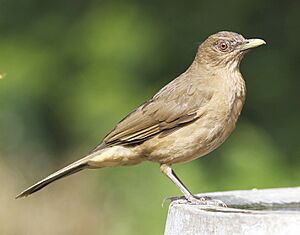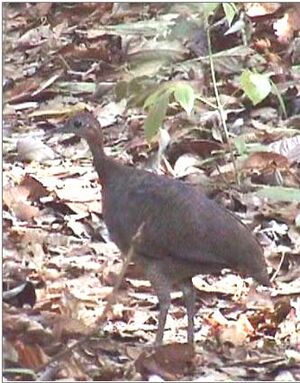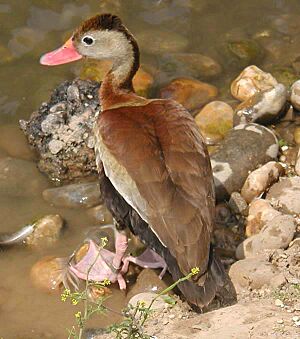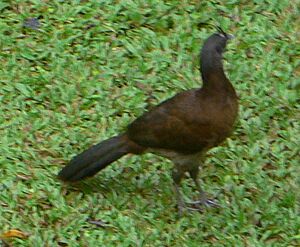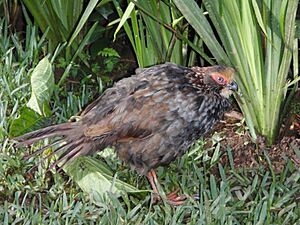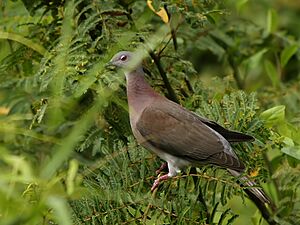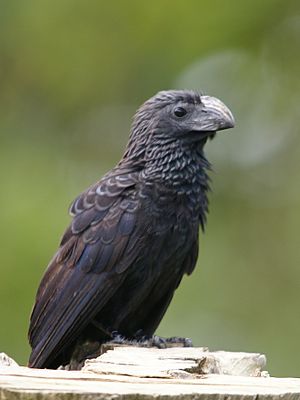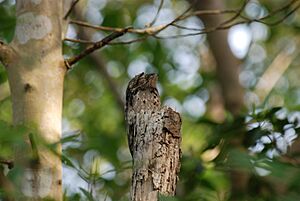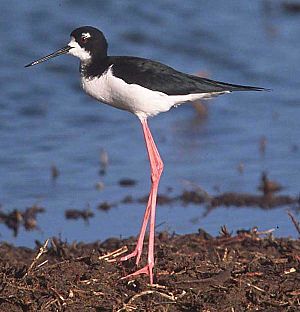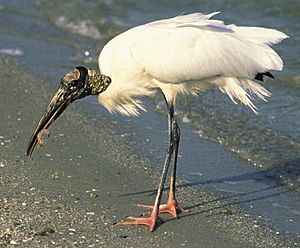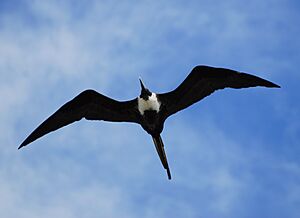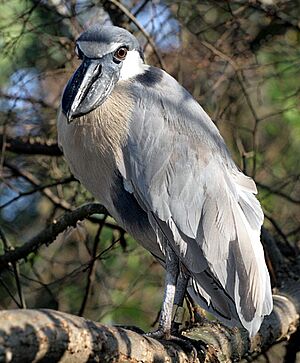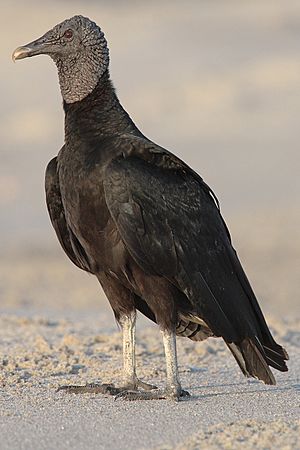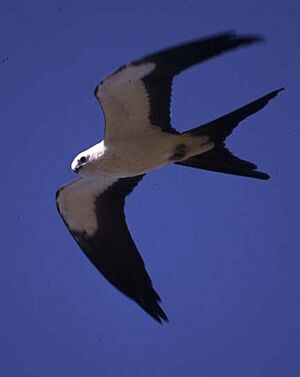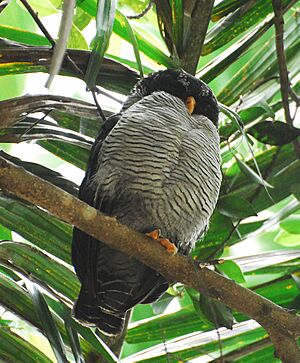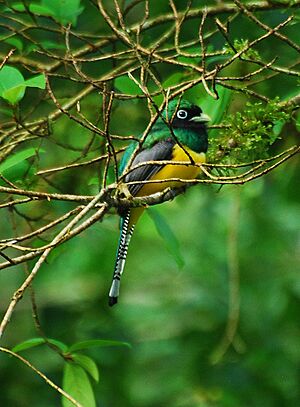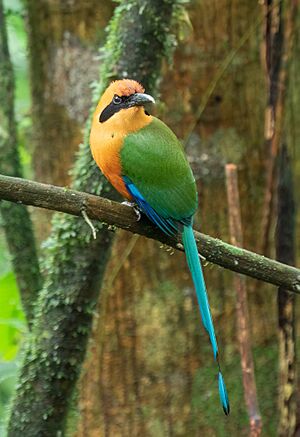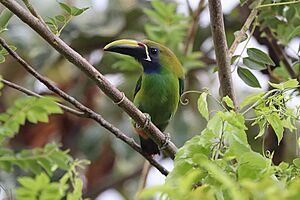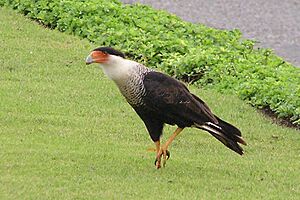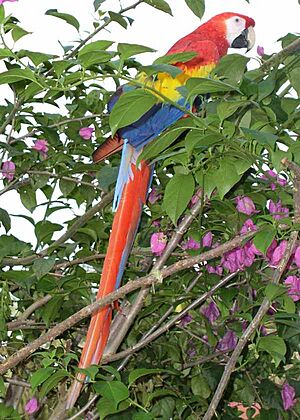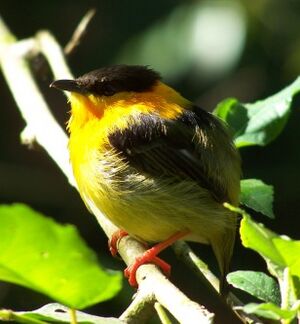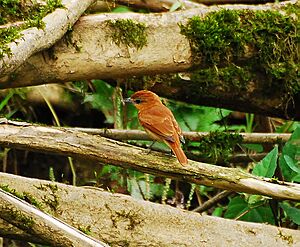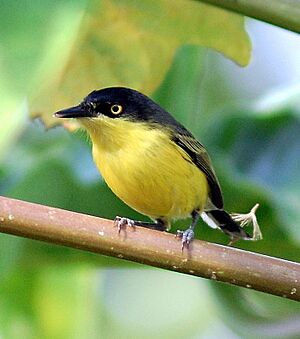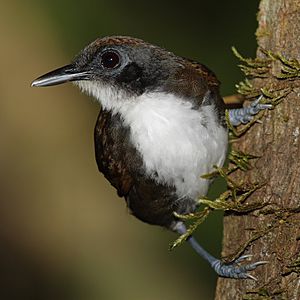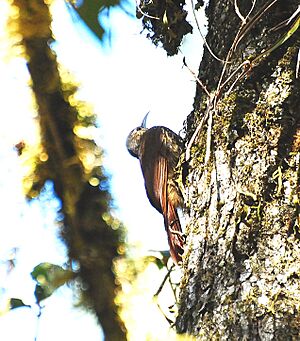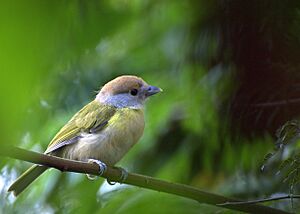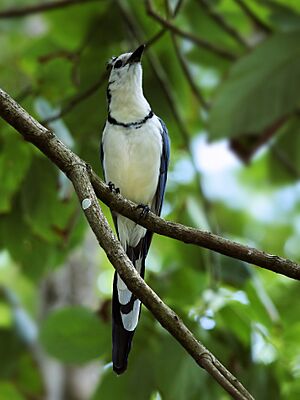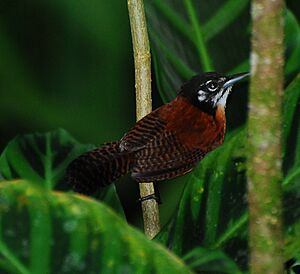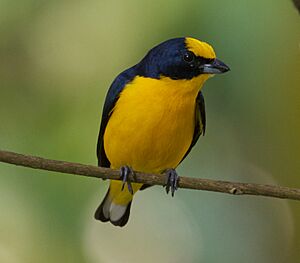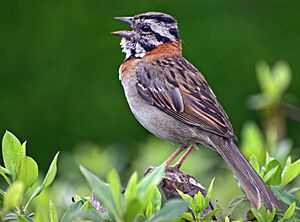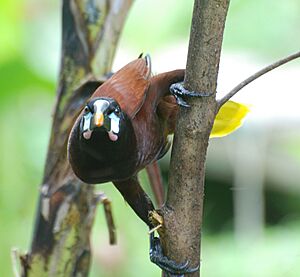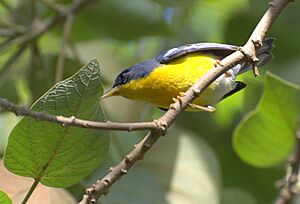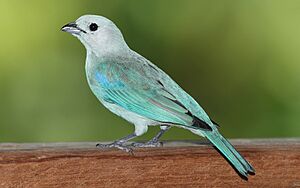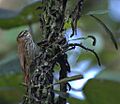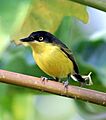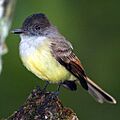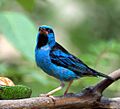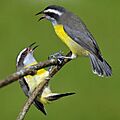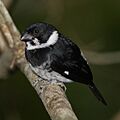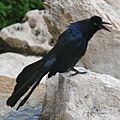List of birds of Costa Rica facts for kids
Costa Rica is a small country, but it's a huge home for birds! It's located in a special part of the world called the Neotropics, which is full of amazing wildlife. As of July 2023, there were 948 different kinds of birds officially recorded here. That's a lot for such a small place!
Some of these birds are truly unique: seven species are found only in Costa Rica. Three of these live only on Cocos Island, a remote island belonging to Costa Rica. Another 73 species are "near-endemic," meaning they live only in Costa Rica and Panama. Sadly, 27 species, including five of the unique ones, are in danger of disappearing forever. With so many birds in a small area, Costa Rica has the highest number of bird species per square kilometer of any country in the Americas. About 600 species live there all the time, while others visit during winter from North America.
Costa Rica's amazing bird diversity is partly thanks to its geology. Millions of years ago, North and South America were separate continents. Over time, volcanoes and earthquakes slowly built up a land bridge, connecting the two continents. This bridge, which became Central America, allowed birds and other animals from both north and south to mix and spread out. For example, hummingbirds crossed into North America a long time ago, while some jays came from the north and later even moved back south!
The country also has many different types of habitats, which are like different neighborhoods for birds. These include swampy mangrove forests along the Pacific coast, wet plains on the Caribbean side, dry lowlands in the north, and tall mountain ranges. The mountains, especially the Talamanca range, act like big walls. This has caused birds on one side of the mountains to become different from their relatives on the other side. A good example is the white-collared manakin on the Caribbean side, which is now a separate species from the orange-collared manakin on the Pacific side. In the past, when sea levels were higher, the mountains were like isolated islands, leading to even more unique species. Over 30 mountain birds are found only in these highlands!
This list of birds follows the official Check-list of North and Middle American Birds from the American Ornithological Society. The names of bird families come from the Clements taxonomy.
Here are some special tags used in the list to tell you more about where the birds are found:
- (A) Accidental - This bird rarely or accidentally shows up in Costa Rica.
- (R?) Residence uncertain - We're not sure if this bird lives in Costa Rica all the time.
- (E) Endemic - This bird is found only in Costa Rica.
- (E-R) Regional endemic - This bird is found only in Costa Rica and Panama.
- (I) Introduced - Humans brought this bird to Costa Rica.
Contents
- Tinamous
- Ducks, Geese, and Waterfowl
- Guans, Chachalacas, and Curassows
- New World Quail
- Grebes
- Pigeons and Doves
- Cuckoos
- Nightjars and Allies
- Potoos
- Swifts
- Hummingbirds
- Rails, Gallinules, and Coots
- Stilts and Avocets
- Plovers and Lapwings
- Jacanas
- Sandpipers and Allies
- Gulls, Terns, and Skimmers
- Storks
- Frigatebirds
- Boobies and Gannets
- Pelicans
- Herons, Egrets, and Bitterns
- Ibises and Spoonbills
- New World Vultures
- Osprey
- Hawks, Eagles, and Kites
- Barn-owls
- Owls
- Trogons
- Motmots
- Kingfishers
- Puffbirds
- Jacamars
- Toucans
- Woodpeckers
- Falcons and Caracaras
- New World and African Parrots
- Manakins
- Cotingas
- Tityras and Allies
- Tyrant Flycatchers
- Typical Antbirds
- Ovenbirds and Woodcreepers
- Vireos, Shrike-babblers, and Erpornis
- Crows, Jays, and Magpies
- Swallows
- Wrens
- Thrushes and Allies
- Finches, Euphonias, and Allies
- New World Sparrows
- Troupials and Allies
- New World Warblers
- Cardinals and Allies
- Tanagers and Allies
- Images for kids
- See also
Tinamous
Order: Tinamiformes Family: Tinamidae
Tinamous are one of the oldest groups of birds. They look a bit like quail or grouse, but they are unique and have their own special family. They are also distantly related to large, flightless birds like rheas and emus.
- Highland tinamou, Nothocercus bonapartei
- Great tinamou, Tinamus major
- Little tinamou, Crypturellus soui
- Thicket tinamou, Crypturellus cinnamomeus
- Slaty-breasted tinamou, Crypturellus boucardi
Ducks, Geese, and Waterfowl
Order: Anseriformes Family: Anatidae
This family includes ducks, geese, and swans. These birds are great at living in water. They have webbed feet, flat bills, and oily feathers that shed water easily.
- Black-bellied whistling-duck, Dendrocygna autumnalis
- Blue-winged teal, Spatula discors
- Muscovy duck, Cairina moschata
- Ring-necked duck, Aythya collaris
- Lesser scaup, Aythya affinis
Guans, Chachalacas, and Curassows
Order: Galliformes Family: Cracidae
Cracidae are large birds, similar to turkeys. Guans and curassows live in trees, while the smaller chachalacas prefer open, bushy areas. They usually have plain feathers, but some have colorful faces.
- Plain chachalaca, Ortalis vetula
- Gray-headed chachalaca, Ortalis cinereiceps
- Crested guan, Penelope purpurascens
- Black guan, Chamaepetes unicolor (E-R)
- Great curassow, Crax rubra (vulnerable)
New World Quail
Order: Galliformes Family: Odontophoridae
These are small, plump birds that live on the ground. They are named "New World quail" because they look and act like quails from other parts of the world, but they are not closely related.
- Tawny-faced quail, Rhynchortyx cinctus
- Buffy-crowned wood-partridge, Dendrortyx leucophrys
- Crested bobwhite, Colinus cristatus
- Black-breasted wood-quail, Odontophorus leucolaemus (E-R)
Grebes
Order: Podicipediformes Family: Podicipedidae
Grebes are small to medium-sized diving birds that live in freshwater. They have special lobed toes that make them excellent swimmers and divers. However, their feet are placed far back on their bodies, making them clumsy on land.
- Least grebe, Tachybaptus dominicus
- Pied-billed grebe, Podilymbus podiceps
Pigeons and Doves
Order: Columbiformes Family: Columbidae
Pigeons and doves are birds with sturdy bodies, short necks, and thin bills. Many species are found in Costa Rica.
- Rock pigeon, Columba livia (I)
- Pale-vented pigeon, Patagioenas cayennensis
- Band-tailed pigeon, Patagioenas fasciata
- Ruddy ground dove, Columbina talpacoti
- White-tipped dove, Leptotila verreauxi
- Buff-fronted quail-dove, Zentrygon costaricensis (E-R)
Cuckoos
Order: Cuculiformes Family: Cuculidae
This family includes cuckoos, roadrunners, and anis. These birds have slender bodies, long tails, and strong legs. Some cuckoos are known for laying their eggs in other birds' nests.
- Groove-billed ani, Crotophaga sulcirostris
- Squirrel cuckoo, Piaya cayana
- Cocos cuckoo, Coccyzus ferrugineus (E) (vulnerable)
Nightjars and Allies
Order: Caprimulgiformes Family: Caprimulgidae
Nightjars are medium-sized birds that are active at night. They usually nest on the ground. They have long wings, short legs, and very short bills. Their soft feathers help them blend in with tree bark or leaves.
- Common nighthawk, Chordeiles minor
- Common pauraque, Nyctidromus albicollis
- Dusky nightjar, Antrostomus saturatus (E-R)
Potoos
Order: Nyctibiiformes Family: Nyctibiidae
Potoos are large, nocturnal birds that eat insects. They are related to nightjars but don't have the bristles around their mouths. They are known for their excellent camouflage, often looking like tree stumps.
- Great potoo, Nyctibius grandis
- Common potoo, Nyctibius griseus
Swifts
Order: Apodiformes Family: Apodidae
Swifts are small birds that spend most of their lives flying. They have very short legs and can only perch on vertical surfaces, like walls or tree trunks. Many swifts have long, swept-back wings that look like a crescent moon.
- Black swift, Cypseloides niger (vulnerable)
- White-collared swift, Streptoprocne zonaris
- Costa Rican swift, Chaetura fumosa (E-R)
Hummingbirds
Order: Apodiformes Family: Trochilidae
Hummingbirds are tiny birds famous for hovering in mid-air by rapidly flapping their wings. They are the only birds that can fly backward! They feed on nectar from flowers.
- White-necked jacobin, Florisuga mellivora
- Green hermit, Phaethornis guy
- Green-breasted mango, Anthracothorax prevostii
- Talamanca hummingbird, Eugenes spectabilis (E-R)
- Fiery-throated hummingbird, Panterpe insignis (E-R)
- Volcano hummingbird, Selasphorus flammula (E-R)
- Coppery-headed emerald, Microchera cupreiceps (E)
- Mangrove hummingbird, Amazilia boucardi (E) (endangered)
Rails, Gallinules, and Coots
Order: Gruiformes Family: Rallidae
This is a large family of small to medium-sized birds that live in dense plants near water, like lakes or swamps. They are usually shy and hard to spot. Most have strong legs and long toes, perfect for walking on soft ground. They tend to be weak fliers.
- Spotted rail, Pardirallus maculatus
- Gray-cowled wood-rail, Aramides cajaneus
- Common gallinule, Gallinula galeata
- Purple gallinule, Porphyrio martinicus
Stilts and Avocets
Order: Charadriiformes Family: Recurvirostridae
This family includes avocets and stilts. Avocets have long legs and bills that curve upwards. Stilts have extremely long legs and long, thin, straight bills. They are wading birds, often seen in shallow water.
- Black-necked stilt, Himantopus mexicanus
- American avocet, Recurvirostra americana
Plovers and Lapwings
Order: Charadriiformes Family: Charadriidae
Plovers and lapwings are small to medium-sized birds with compact bodies, short necks, and long, pointed wings. They live in open areas, often near water.
- Southern lapwing, Vanellus chilensis
- Black-bellied plover, Pluvialis squatarola
- Killdeer, Charadrius vociferus
Jacanas
Order: Charadriiformes Family: Jacanidae
Jacanas are wading birds found in tropical regions. You can easily spot them by their huge feet and claws, which allow them to walk on floating plants in shallow lakes.
- Northern jacana, Jacana spinosa
Sandpipers and Allies
Order: Charadriiformes Family: Scolopacidae
This is a large and diverse family of shorebirds, including sandpipers, curlews, and snipes. Most of these birds eat small bugs they find in mud or soil. Their different leg and bill lengths allow many species to feed in the same area without competing for food.
- Whimbrel, Numenius phaeopus
- Sanderling, Calidris alba
- Least sandpiper, Calidris minutilla
- Spotted sandpiper, Actitis macularius
- Lesser yellowlegs, Tringa flavipes
Gulls, Terns, and Skimmers
Order: Charadriiformes Family: Laridae
This family includes gulls, terns, and skimmers. They are usually gray or white, often with black markings. They have longish bills and webbed feet. Terns dive for fish, while skimmers fly low over the water, using their long lower bill to scoop up small fish.
- Laughing gull, Leucophaeus atricilla
- Least tern, Sternula antillarum
- Royal tern, Thalasseus maximus
- Black skimmer, Rynchops niger
Storks
Order: Ciconiiformes Family: Ciconiidae
Storks are large wading birds with long legs, long necks, and strong, long bills. They are usually silent, but they make clattering sounds with their bills at the nest. Their nests can be very large and used for many years.
- Jabiru, Jabiru mycteria
- Wood stork, Mycteria americana
Frigatebirds
Order: Suliformes Family: Fregatidae
Frigatebirds are large seabirds found over tropical oceans. They are mostly black or black and white, with long wings and deeply forked tails. Male frigatebirds have colorful throat pouches that they can inflate. They are amazing fliers and can stay in the air for more than a week!
- Magnificent frigatebird, Fregata magnificens
- Great frigatebird, Fregata minor
Boobies and Gannets
Order: Suliformes Family: Sulidae
This family includes gannets and boobies. Both are medium to large seabirds that live near coasts and dive headfirst into the water to catch fish.
- Masked booby, Sula dactylatra
- Blue-footed booby, Sula nebouxii
- Brown booby, Sula leucogaster
- Red-footed booby, Sula sula
Pelicans
Order: Pelecaniformes Family: Pelecanidae
Pelicans are large water birds with a unique pouch under their beak, which they use to scoop up fish. They have webbed feet with four toes.
- Brown pelican, Pelecanus occidentalis
Herons, Egrets, and Bitterns
Order: Pelecaniformes Family: Ardeidae
This family includes bitterns, herons, and egrets. Herons and egrets are medium to large wading birds with long necks and legs. Bitterns are usually shorter-necked and more cautious. Unlike other long-necked birds, they fly with their necks pulled back.
- Great blue heron, Ardea herodias
- Great egret, Ardea alba
- Snowy egret, Egretta thula
- Green heron, Butorides virescens
- Boat-billed heron, Cochlearius cochlearius
Ibises and Spoonbills
Order: Pelecaniformes Family: Threskiornithidae
This family includes ibises and spoonbills. They are large birds that live on land or wade in water. They have long, wide wings and are strong fliers, even soaring high in the sky.
- White ibis, Eudocimus albus
- Roseate spoonbill, Platalea ajaja
New World Vultures
Order: Cathartiformes Family: Cathartidae
New World vultures are not closely related to vultures from other parts of the world, but they look similar because they evolved to do the same job: eating dead animals. Unlike Old World vultures, which find food by sight, New World vultures have a great sense of smell to find carcasses.
- King vulture, Sarcoramphus papa
- Black vulture, Coragyps atratus
- Turkey vulture, Cathartes aura
Osprey
Order: Accipitriformes Family: Pandionidae
The osprey is the only species in its family. It's a medium-large bird of prey that specializes in eating fish. You can find ospreys all over the world.
- Osprey, Pandion haliaetus
Hawks, Eagles, and Kites
Order: Accipitriformes Family: Accipitridae
This family includes hawks, eagles, and kites. These birds of prey have strong, hooked beaks for tearing meat, powerful legs with sharp talons, and excellent eyesight.
- Swallow-tailed kite, Elanoides forficatus
- Harpy eagle, Harpia harpyja
- White hawk, Pseudastur albicollis
- Roadside hawk, Rupornis magnirostris
- Red-tailed hawk, Buteo jamaicensis
Barn-owls
Order: Strigiformes Family: Tytonidae
Barn-owls are medium to large owls with big heads and unique heart-shaped faces. They have long, strong legs with powerful talons.
- Barn owl, Tyto alba
Owls
Order: Strigiformes Family: Strigidae
Typical owls are mostly solitary birds of prey that are active at night. They have large eyes that face forward, good hearing, a hooked beak, and a circle of feathers around each eye called a facial disk.
- Spectacled owl, Pulsatrix perspicillata
- Great horned owl, Bubo virginianus
- Costa Rican pygmy-owl, Glaucidium costaricanum (E-R)
- Black-and-white owl, Strix nigrolineata
Trogons
Order: Trogoniformes Family: Trogonidae
This family includes trogons and quetzals. They live in tropical forests worldwide and eat insects and fruit. They have wide bills and weak legs. Trogons have soft, often colorful feathers, and males and females look different.
- Slaty-tailed trogon, Trogon massena
- Baird's trogon, Trogon bairdii (E-R)
- Collared trogon, Trogon collaris
- Resplendent quetzal, Pharomachrus mocinno
Motmots
Order: Coraciiformes Family: Momotidae
Motmots have colorful feathers and long, fancy tails that they wag back and forth. For most species, the feathers near the end of their two longest tail feathers fall off, leaving a bare shaft that looks like a tennis racket!
- Lesson's motmot, Momotus lessonii
- Rufous motmot, Baryphthengus martii
- Turquoise-browed motmot, Eumomota superciliosa
Kingfishers
Order: Coraciiformes Family: Alcedinidae
Kingfishers are medium-sized birds with large heads, long, pointed bills, short legs, and short tails. They are known for diving into water to catch fish.
- Ringed kingfisher, Megaceryle torquatus
- Belted kingfisher, Megaceryle alcyon
- Amazon kingfisher, Chloroceryle amazona
Puffbirds
Order: Piciformes Family: Bucconidae
Puffbirds are related to jacamars but don't have their shiny colors. They are mostly brown, reddish-brown, or gray, with large heads and flat bills with hooked tips. Their loose, fluffy feathers and short tails make them look stout and "puffy."
- White-necked puffbird, Notharchus hyperrhynchus
- White-whiskered puffbird, Malacoptila panamensis
Jacamars
Order: Piciformes Family: Galbulidae
Jacamars are elegant, shiny birds with long bills and tails. They catch insects in flight. They look and act like bee-eaters from other parts of the world, but they are more closely related to puffbirds.
- Rufous-tailed jacamar, Galbula ruficauda
- Great jacamar, Jacamerops aureus
Toucans
Order: Piciformes Family: Ramphastidae
Toucans are famous for their huge, colorful bills, which can be half as long as their bodies! They are brightly marked birds found in tropical areas.
- Northern emerald-toucanet, Aulacorhynchus prasinus
- Collared aracari, Pteroglossus torquatus
- Fiery-billed aracari, Pteroglossus frantzii (E-R)
- Keel-billed toucan, Ramphastos sulfuratus
- Yellow-throated toucan, Ramphastos ambiguus
Woodpeckers
Order: Piciformes Family: Picidae
Woodpeckers are small to medium-sized birds with chisel-like beaks, short legs, stiff tails, and long tongues for catching insects. Many species tap loudly on tree trunks with their beaks.
- Acorn woodpecker, Melanerpes formicivorus
- Black-cheeked woodpecker, Melanerpes pucherani
- Golden-naped woodpecker, Melanerpes chrysauchen (E-R)
- Lineated woodpecker, Dryocopus lineatus
Falcons and Caracaras
Order: Falconiformes Family: Falconidae
This family includes falcons and caracaras, which are birds of prey active during the day. Unlike hawks and eagles, they kill their prey with their beaks instead of their talons.
- Laughing falcon, Herpetotheres cachinnans
- Crested caracara, Caracara plancus
- American kestrel, Falco sparverius
- Peregrine falcon, Falco peregrinus
New World and African Parrots
Order: Psittaciformes Family: Psittacidae
Parrots are small to large birds with a special curved beak. Their upper beak can move slightly, and they usually stand upright. All parrots have two toes pointing forward and two pointing backward on each foot.
- Sulphur-winged parakeet, Pyrrhura hoffmanni (E-R)
- Scarlet macaw, Ara macao
- Great green macaw, Ara ambigua (endangered)
- Orange-chinned parakeet, Brotogeris jugularis
- Red-fronted parrotlet, Touit costaricensis (E-R) (vulnerable)
- Yellow-naped parrot, Amazona auropalliata (endangered)
Manakins
Order: Passeriformes Family: Pipridae
Manakins are small, compact forest birds. The males are usually brightly colored, while the females are often duller and green. Manakins eat small fruits, berries, and insects.
- Long-tailed manakin, Chiroxiphia linearis
- White-collared manakin, Manacus candei
- Orange-collared manakin, Manacus aurantiacus (E-R)
- Red-capped manakin, Ceratopipra mentalis
Cotingas
Order: Passeriformes Family: Cotingidae
Cotingas are forest birds found in tropical South America. Not much is known about all the different kinds, but they all have wide bills with hooked tips, rounded wings, and strong legs. The males of many species are brightly colored or have fancy plumes.
- Bare-necked umbrellabird, Cephalopterus glabricollis (E-R) (endangered)
- Lovely cotinga, Cotinga amabilis
- Turquoise cotinga, Cotinga ridgwayi (E-R) (vulnerable)
- Three-wattled bellbird, Procnias tricarunculata (vulnerable)
- Yellow-billed cotinga, Carpodectes antoniae (E-R) (endangered)
Tityras and Allies
Order: Passeriformes Family: Tityridae
Tityridae are passerine birds found in forests and woodlands. They are small to medium-sized birds. They don't have the complex songs of other songbirds, and most have plain colors.
- Masked tityra, Tityra semifasciata
- Cinnamon becard, Pachyramphus cinnamomeus
- Rose-throated becard, Pachyramphus aglaiae
Tyrant Flycatchers
Order: Passeriformes Family: Tyrannidae
Tyrant flycatchers are passerine birds found throughout North and South America. They look a bit like flycatchers from other parts of the world but are stronger and have tougher bills. Most eat insects.
- Common tody-flycatcher, Todirostrum cinereum
- Great kiskadee, Pitangus sulphuratus
- Tropical kingbird, Tyrannus melancholicus
- Scissor-tailed flycatcher, Tyrannus forficatus
- Yellowish flycatcher, Empidonax flavescens
- Black-capped flycatcher, Empidonax atriceps (E-R)
- Cocos flycatcher, Nesotriccus ridgwayi (E) (vulnerable)
Typical Antbirds
Order: Passeriformes Family: Thamnophilidae
Antbirds are a large family of small passerine birds found in Central and South America. They are forest birds that usually eat insects on or near the ground. Many follow columns of army ants to catch insects fleeing from the ants. They often have plain colors like brown, black, and white.
- Great antshrike, Taraba major
- Black-hooded antshrike, Thamnophilus bridgesi (E-R)
- Bicolored antbird, Gymnopithys bicolor
Ovenbirds and Woodcreepers
Order: Passeriformes Family: Furnariidae
This large family includes small insect-eating birds found in Central and South America. They are named "ovenbirds" because some species build fancy, oven-like nests out of clay. Woodcreepers are brownish birds that climb tree trunks, supported by their stiff tails, looking for insects.
- Olivaceous woodcreeper, Sittasomus griseicapillus
- Spot-crowned woodcreeper, Lepidocolaptes affinis
- Streaked xenops, Xenops rutilans
- Ruddy treerunner, Margarornis rubiginosus (E-R)
Vireos, Shrike-babblers, and Erpornis
Order: Passeriformes Family: Vireonidae
Vireos are small to medium-sized passerine birds, usually greenish. They look like wood warblers but have heavier bills.
- Rufous-browed peppershrike, Cyclarhis gujanensis
- Yellow-winged vireo, Vireo carmioli (E-R)
- Red-eyed vireo, Vireo olivaceus
Crows, Jays, and Magpies
Order: Passeriformes Family: Corvidae
This family includes crows, ravens, jays, and magpies. Corvids are larger than average passerine birds, and some of the bigger species are very intelligent.
- Silvery-throated jay, Cyanolyca argentigula (E-R)
- Azure-hooded jay, Cyanolyca cucullata
- White-throated magpie-jay, Calocitta formosa
- Brown jay, Psilorhinus morio
Swallows
Order: Passeriformes Family: Hirundinidae
Swallows are birds adapted for catching insects in the air. They have slender bodies, long, pointed wings, and a short bill with a wide mouth. Their feet are better for perching than walking.
- Tree swallow, Tachycineta bicolor
- Mangrove swallow, Tachycineta albilinea
- Northern rough-winged swallow, Stelgidopteryx serripennis
- Barn swallow, Hirundo rustica
Wrens
Order: Passeriformes Family: Troglodytidae
Wrens are mostly small and hard to see, but they have very loud songs! These birds have short wings and thin, downward-curved bills. Many species hold their tails straight up. They all eat insects.
- House wren, Troglodytes aedon
- Ochraceous wren, Troglodytes ochraceus (E-R)
- Timberline wren, Thryorchilus browni (E-R)
- Bay wren, Cantorchilus nigricapillus
- Isthmian wren, Cantorchilus elutus (E-R)
Thrushes and Allies
Order: Passeriformes Family: Turdidae
Thrushes are plump, soft-feathered passerine birds. They are small to medium-sized and eat insects, or sometimes a mix of things. They often feed on the ground, and many have beautiful songs.
- Black-faced solitaire, Myadestes melanops (E-R)
- Sooty thrush, Turdus nigrescens (E-R)
- Clay-colored thrush, Turdus grayi
- White-throated thrush, Turdus assimilis
Finches, Euphonias, and Allies
Order: Passeriformes Family: Fringillidae
Finches are seed-eating passerine birds. They are small to medium-sized and have strong, cone-shaped beaks. They fly with a bouncy motion, flapping and then gliding with closed wings. Most sing well.
- Golden-browed chlorophonia, Chlorophonia callophrys (E-R)
- Thick-billed euphonia, Euphonia laniirostris
- Spot-crowned euphonia, Euphonia imitans (E-R)
- Yellow-bellied siskin, Spinus xanthogastra
New World Sparrows
Order: Passeriformes Family: Passerellidae
These birds are often called sparrows, but they are not closely related to the "Old World sparrows." Many of them have unique patterns on their heads.
- Sooty-capped chlorospingus, Chlorospingus pileatus (E-R)
- Costa Rican brushfinch, Arremon costaricensis (E-R)
- Sooty-faced finch, Arremon crassirostris (E-R)
- Volcano junco, Junco vulcani (E-R)
- Rufous-collared sparrow, Zonotrichia capensis
- Large-footed finch, Pezopetes capitalis (E-R)
- Cabanis's ground-sparrow, Melozone cabanisi (E)
- Yellow-thighed brushfinch, Atlapetes tibialis (E-R)
Troupials and Allies
Order: Passeriformes Family: Icteridae
Icterids are a group of small to medium-sized, often colorful, passerine birds found only in the Americas. This family includes grackles and orioles. Most species are mainly black, often with bright yellow, orange, or red markings.
- Montezuma oropendola, Psarocolius montezuma
- Scarlet-rumped cacique, Cacicus uropygialis
- Orchard oriole, Icterus spurius
- Baltimore oriole, Icterus galbula
- Great-tailed grackle, Quiscalus mexicanus
New World Warblers
Order: Passeriformes Family: Parulidae
New World warblers are a group of small, often colorful, passerine birds found only in the Americas. Most live in trees, but some live on the ground. Most members of this family eat insects.
- Ovenbird, Seiurus aurocapilla
- Flame-throated warbler, Leiothlypis gutturalis (E-R)
- Tropical parula, Setophaga pitiayumi
- Yellow warbler, Setophaga petechia
- Black-cheeked warbler, Basileuterus melanogenys (E-R)
- Collared redstart, Myioborus torquatus (E-R)
Cardinals and Allies
Order: Passeriformes Family: Cardinalidae
Cardinals are a family of strong, seed-eating birds with powerful bills. They usually live in open woodlands. Males and females often have different feather colors.
- Summer tanager, Piranga rubra
- Flame-colored tanager, Piranga bidentata
- Red-throated ant-tanager, Habia fuscicauda
- Black-cheeked ant-tanager, Habia atrimaxillaris (E) (endangered)
- Rose-breasted grosbeak, Pheucticus ludovicianus
- Indigo bunting, Passerina cyanea
Tanagers and Allies
Order: Passeriformes Family: Thraupidae
Tanagers are a large group of small to medium-sized passerine birds found only in the Americas, mostly in tropical areas. Many species are brightly colored. They eat a variety of foods, including fruits, seeds, and insects. Most have short, rounded wings.
- Blue-gray tanager, Thraupis episcopus
- Golden-hooded tanager, Stilpnia larvata
- Spangle-cheeked tanager, Tangara dowii (E-R)
- Green honeycreeper, Chlorophanes spiza
- Black-and-yellow tanager, Chrysothlypis chrysomelas (E-R)
- Scarlet-rumped tanager, Ramphocelus passerinii
- Red-legged honeycreeper, Cyanerpes cyaneus
- Bananaquit, Coereba flaveola
- Cocos finch, Pinaroloxias inornata (E) (vulnerable)
- Variable seedeater, Sporophila corvina
- Black-headed saltator, Saltator atriceps
Images for kids
See also
- List of amphibians of Costa Rica
- List of birds
- Lists of birds by region
- List of mammals of Costa Rica
- List of non-marine molluscs of Costa Rica
- List of reptiles of Costa Rica


